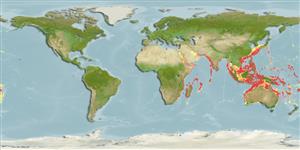Common names from other countries
Environment: milieu / climate zone / depth range / distribution range
экология
ассоциированный с рифами; пределы глубины 3 - 15 m (Ref. 8294). Tropical
Indo-West Pacific: West to Red Sea; north to Japan, east to Vanuatu; south to Australia.
Length at first maturity / Size / Вес / Возраст
Maturity: Lm ? range ? - ? cm Max length : 50.0 cm COLD самец/пол неопределен; (Ref. 269)
Colonies form mounds up to 50 cm in diameter that may dominate large patches of reef. The colonies are composed of thin tubes (the "organ pipes"), 0.2 cm diameter in length, cemented together by horizontal plates at intervals of several centimeters. In life, the corals have white polyps that may cover the corallum. The skeleton is deep red (Ref. 269).
Maximum depth from Ref. 123855. Abundant in mid-shelf reefs, becomes prolific at a depth of 20 m. Less common in muddy coastal areas (Ref. 101098). Common from the reef flat to intermediate depths (Ref. 296).
Life cycle and mating behavior
половая зрелость | размножение | нерест | икра | Fecundity | личинки
Members of the class Anthozoa are either gonochoric or hermaphroditic. Mature gametes are shed into the coelenteron and spawned through the mouth. Life cycle: The zygote develops into a planktonic planula larva. Metamorphosis begins with early morphogenesis of tentacles, septa and pharynx before larval settlement on the aboral end.
Основная ссылка
ссылки | координатор | соавторы
Ross, M.A. and G. Hodgson. 1981. (Ref. 8294)
Статус Красного Списка МСОП (Ref. 130435)
Статус СИТЕС (Ref. 108899)
Not Evaluated
Использование человеком
рыболовство: потенциальный рыбохозяйственный объект
| FishSource | Sea Around Us
инструменты
дополнительная информация
Возраст/РазмерыростЗависимость между длиной и массой телаЗависимость между длинамиморфологияличинкичисленность
ресурсы в Интернет
Estimates based on models
Preferred temperature
(Ref.
115969): 11.5 - 23.7, mean 17.4 (based on 629 cells).
Уязвимость
Moderate vulnerability (40 of 100).
Категория цены
Unknown.
